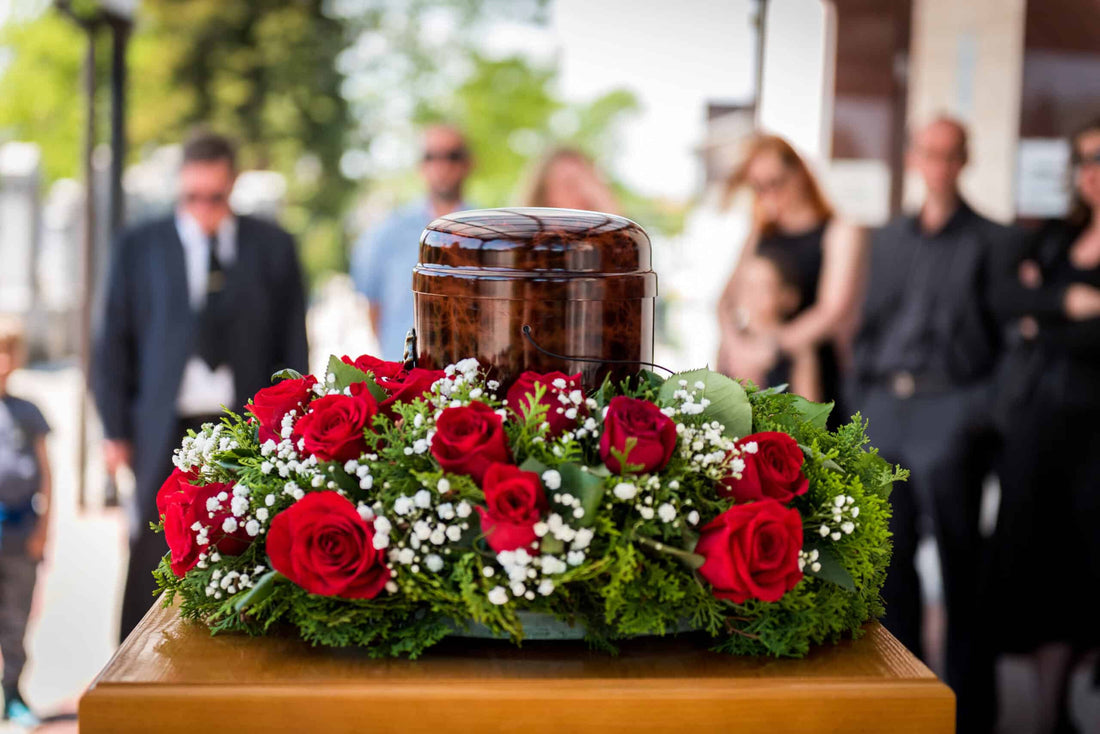The key takeaway: Cremation takes 1.5–3 hours (800–1000°C), but families wait 7–14 days due to legal formalities. Delays vary based on body size, casket material, and cremation tech. High heat ensures complete remains processing. Honor their legacy with urns for ashes or buy urn online.
Ever wondered how long it takes to cremate a body? While the active cremation time spans 1.5–3 hours in the chamber, the full journey from passing to ashes stretches 7–14 days, tangled in legal formalities like death certificates, mandatory 24–48 hour waiting periods, and administrative delays. This guide peels back layers of complexity—exploring how body composition, casket material, and modern cremation technology reshape timelines—while revealing why meticulous steps ensure both dignity and clarity. Discover how these factors intertwine, and why selecting the perfect urn for ashes becomes a meaningful final act of remembrance.
- Understanding cremation time at a glance
- The active cremation process: a step-by-step timeline
- Key factors that influence the cremation time
- From start to finish: understanding the total cremation timeline
- What happens after the cremation chamber?
- Receiving the ashes: ensuring identity and final preparations

Understanding cremation time at a glance
The cremation process itself typically lasts between 1.5 to 3 hours. This active cremation phase occurs in a specialized chamber where temperatures reach approximately 850°C. However, the total timeline from death to receiving ashes often spans 7 to 14 days. Why such a gap? Administrative requirements, legal waiting periods, and logistical arrangements explain this extended period.
Three key elements influence cremation duration:
- Body size and composition
- Cremation equipment specifications
- Pre-cremation documentation
In brief: The cremation timeline
- Active Cremation Time: The thermal process takes 1.5 to 3 hours at temperatures reaching 850°C
- Total Turnaround Time: 7 to 14 days from death to ashes, including legal formalities and equipment preparation
- Key Influencing Factors: Body size, casket material, and cremation technology
Once the process completes, remains undergo processing before placement in a vessel. You can explore various urns for ashes or buy urn online for a meaningful remembrance.
The active cremation process: a step-by-step timeline
When the cremation begins, the coffin containing the deceased is carefully placed into the cremation chamber, also known as a cremator. This sealed chamber is specifically designed to withstand extreme temperatures and ensure complete combustion.
Inside the cremator, temperatures rapidly rise to between 800 and 1000 degrees Celsius (1400-1800°F). This intense heat, not direct flames, is the primary factor that breaks down the body. The cremation chamber uses powerful burners that create this controlled, high-heat environment.
As the process continues, the soft tissues of the body vaporize, and the coffin itself begins to burn. The extreme heat calcifies the bones, which are the last remaining parts of the body. This process takes between 1.5 and 3 hours for an average-sized adult.
Once the cremation cycle is complete, the remains are left to cool. This cooling period is essential before the remains can be safely handled and processed further. What remains are primarily bone fragments that will later be processed into what we commonly refer to as ashes.
Key factors that influence the cremation time
The cremation process typically lasts 1.5 to 3 hours for adults, though specific factors can shorten or extend this timeframe. Variations in body composition, equipment efficiency, and procedural conditions all play a role in determining the exact duration.
The primary factor influencing the cremation time is the deceased's body mass and bone density. A larger individual will naturally require a longer duration for the process to complete respectfully.
- Body size and weight: Larger bodies take longer due to increased tissue and bone volume. Adults with higher body mass may require closer to 3 hours, while infants can be cremated in 30 minutes due to minimal mass.
- Bone density: Though less critical, higher density slightly extends cremation time as denser bones require more sustained heat to break down fully.
- Cremation container: Combustible materials like wood, cardboard, or natural fibers (e.g., wicker, bamboo) burn faster. Non-combustible materials (e.g., metal) are prohibited to avoid equipment damage and ensure safety.
- Cremation equipment technology: Modern cremators operate at 1,400–2,000°F, with preheated chambers ensuring consistent temperatures for even breakdown. Older equipment or cold starts (e.g., early-day cremations) may prolong the process.
Cremation times for infants or children are notably shorter, often 30 minutes to 1 hour, due to their smaller size and lower body mass. After cremation, ashes are processed into fine particles and placed in an urn. For options, Olivia Memorials offers eco-friendly, biodegradable, and personalized urns to honor individual preferences.

From start to finish: understanding the total cremation timeline
Cremation timelines often surprise families. While the active process lasts 4-6 hours, legal requirements extend the full timeline to 7-14 days. This delay ensures proper documentation and error prevention through mandatory administrative steps.
Before cremation, families must obtain a death certificate and cremation permit. Some regions, like Maryland, require a 24-48 hour waiting period for cause-of-death verification, especially during medical investigations.
| Phase | Description | Estimated Duration |
|---|---|---|
| 1. Administrative & Legal | Documentation and mandatory 24-48 hour waiting period | 2-5 business days |
| 2. Cremation Day | Transport, cremation (800-1,000°F), and cooling | 4-6 hours |
| 3. Final Processing | Remains pulverization and urn placement | 1-3 business days |
Body size, bone density, and cremation technology affect processing time. Larger individuals or denser bones require longer exposure to high temperatures, while infants/children cremate faster due to smaller mass. Post-cremation, ashes cool before being processed into fine particles.
Families receive ashes in temporary containers or chosen urns. Personalized options are available through olivia-memorials.com, balancing legal compliance with respectful memorialization. This structured process honors both legal requirements and family needs while maintaining dignity for the deceased.
What happens after the cremation chamber?
Processing the cremated remains
After cremation, remains consist of bone fragments, not ash. These cool for hours before being ground into a fine, sand-like texture using a cremulator (or manual methods). The resulting "cremated remains" weigh about 3.5% of the original body mass—typically 2.4 kg for adults, ranging from 876g to 3.7kg. Composed primarily of calcium phosphate and trace minerals, they’re non-toxic and inert. This process ensures a uniform, respectful presentation for families.
Handling non-combustible materials
Metals like:
- Medical implants (titanium hip replacements, surgical screws)
- Dental fillings or gold teeth
- Casket hardware (nails, hinges)
survive the heat. Technicians remove them using magnets or manual sorting before grinding. Pacemakers must be extracted beforehand to prevent explosions at temperatures above 760°C. Recovered metals often enter recycling programs, funding charities or environmental initiatives. Smaller fragments, like melted dental gold, stay in ashes but don’t alter their texture.
Remains are first placed in a temporary container before transfer to a permanent urn. Explore durable, meaningful options—from natural wood to biodegradable vessels—at olivia-memorials.com for personalized memorials.
Receiving the ashes: ensuring identity and final preparations
The Chain of Identification: Guaranteeing Accuracy
Strict protocols ensure accurate identification during cremation. A durable, heat-resistant metal tag with a unique number accompanies the deceased, remaining with the remains until placed in the urn. This prevents mix-ups and guarantees families receive their loved one’s ashes.
The strict identification protocol is a cornerstone of the cremation process, ensuring that the family receives the correct cremated remains of their loved one with absolute certainty.
From Cremation to Urn: The Final Steps
After processing, ashes go into a temporary container or chosen urn, along with a cremation certificate. A sealed, labeled urn—often engraved for personalization—holds the ashes and identification tag. Options include burial, scattering in approved areas, or placement in a columbarium. Explore meaningful urns at olivia-memorials.com.
The cremation process, though methodical and precise, concludes with a deeply personal step: choosing an urn to honor your loved one. With identification protocols ensuring accuracy, the final remains symbolize both closure and a lasting tribute. Selecting an urn becomes a meaningful gesture, offering a dignified resting place that reflects a life well-lived.

FAQ
Why Is There a Mandatory Waiting Period Before Cremation?
Many states, like Texas, require a 48-hour waiting period after death before cremation can occur. This legal requirement allows time for final confirmations, including verification of the death certificate and cremation permit. Exceptions exist for urgent cases, such as public health concerns or religious reasons, which may require written waivers from a medical examiner or judge. These protocols ensure all administrative and ethical steps are followed respectfully.
When Do Cremations Typically Occur?
Cremations are usually scheduled during standard business hours, though timing depends on the crematorium’s availability and logistics. The active cremation process itself takes 1.5–3 hours, but the full timeline—from death to ash return—averages 7–14 days. Scheduling may also align with administrative clearances, such as obtaining permits or completing paperwork, which often occur on business days.
What Is the Average Duration of the Cremation Process?
The actual cremation, where the body is exposed to intense heat (1,400–1,800°F), lasts 1.5–3 hours. This timeframe varies based on factors like body size, bone density, and the type of cremation container used. Afterward, cooling and processing (removing metals, pulverizing bone fragments) add 1–2 hours. The entire physical process at the crematorium typically takes 3–5 hours.
Why Does It Take Up to Two Weeks to Receive the Ashes?
The extended timeline includes multiple steps beyond the cremation itself. After death, families must complete legal paperwork (death certificate, cremation permit), which can take 1–3 days. Mandatory waiting periods (24–48 hours) and crematory scheduling further delay the process. Post-cremation, cooling, metal removal, and ash processing add 1–3 business days. Delays from holidays, equipment maintenance, or investigations can prolong this further.
Are Clothing or Personal Items Removed Before Cremation?
Families may choose to dress the deceased in clothing or include personal items in the cremation container. However, non-combustible materials (e.g., zippers, synthetic fabrics) are removed beforehand to avoid contamination. Pacemakers and other medical devices are always extracted prior to cremation for safety. Any metals remaining after cremation (implants, dental work) are separated from the ashes afterward.
What Should Be Avoided Immediately After a Death?
Avoid making irreversible decisions without legal documentation. Do not proceed with cremation without a signed death certificate or cremation permit. Delaying permits or autopsies can cause setbacks. Additionally, avoid embalming if cremation is planned, as it’s unnecessary and may complicate the process. Focus first on notifying authorities, securing documents, and contacting a funeral director.
Which Body Parts or Materials Are Removed Before Cremation?
Before cremation, pacemakers and battery-operated devices must be removed to prevent explosions during the process. Non-combustible items like metal implants (hip replacements, dental fillings) or casket hardware remain with the body but are separated from the ashes afterward. Organic materials, including clothing and caskets, are cremated alongside the body.
What Does Religion Say About Cremation?
Religious perspectives vary. Christianity, Buddhism, and Hinduism widely accept cremation, though some denominations prefer burial. Islam and Orthodox Judaism generally prohibit it. Most crematoriums respect diverse beliefs and ensure the process is conducted with dignity. Families should consult religious leaders for guidance, but cremation’s practicality and environmental benefits have made it increasingly common across faiths.
Which Body Parts Do Not Burn During Cremation?
Bones and metal implants (e.g., surgical screws, dental fillings) do not burn. The intense heat calcifies bones, leaving fragments that are later processed into fine ashes. Metals like titanium or steel implants survive cremation due to their high melting points and are removed magnetically or manually afterward. These materials are often recycled responsibly, while the ashes returned to families consist solely of processed bone particles.


